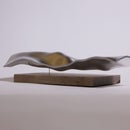Introduction: CNC Light Drawing
Light drawing has been around for quite a while now, it is perhaps as old as photography itself. The basic premise, as you probably know involves taking a long exposure picture and moving a light source. Here I wanted to do a 3D light drawing that you could see from many angles.
Without really noticing, this project is quite personal to me. Exactly a year ago I was doing a very similar project. It was actually the time when I was having my interviews to join Pier 9 as an Artist in Residence (AiR). One of my interviewers wasn't able to make it to my meeting and I was asked to write a couple of paragraphs explaining why I wanted to be an AiR. Words not being my strongest suit I decided to do a 48 (49 thanks to daylight savings) hour project that weekend instead (https://www.instructables.com/id/3D-Light-Painting).
Enough of the past! We have advance machines and and some crazy gear these days! Time to bring light painting to a whole new level!
Step 1: Inspiration
Thinking of what to base the 3D drawing of I realized that perhaps Eadweard Muybridge could help, after all he was one of the pioneers in the realm of photography and movement.
At the end I opted for sculpting a bird. Since I am a lot better modeling organic objects by hand and I was tired of spending months in front of computers I dropped the mouse and grabbed some clay. Some quick google images gave me a quick class in bird anatomy.
Step 2: Digitalizing
With the help of Gabe Patin we carefully scanned the clay bird in the three positions I was going to use. It takes some patience to get the scans right but the Spider form Artec does an incredible job. Gabe also did an amazing instructable on how to use these scanners, make sure to go through it if you ever need to use one.
Step 3: Bullet Time Shot
Since the beginning I knew I wanted to create a three dimensional light painting. This was a challenge for a couple of reasons; not only do you need to program/ create the model in 3D but you also need some way to see it in 3D too. I wanted the camera to orbit about the model in order to really see its 3d form, some sort of Matrix Bullet Time Shot.
Of course I wasn't going to have 1000 cameras fixed together to make the shot, but lucky for me I didn't have to... After all I am using a CNC machine to do the drawings, I'll let her do the exact same job over and over again, while I slowly move the camera on a dolly. To make sure I was always pointing at the same center I used a laser pointer and kept pointing to the center of the machine.
In total I needed to take the same shot over 40 times to get the travel I wanted, this meant that my G-code had to be fast and short!
Step 4: Translating Form Into Movement
So I made a tangible bird to convert it into digital points to then have a computer trace it real life to recorded it into pixels... WORKFLOWS!!!
Knowing I needed to simplify the bird in order to create a simple toolpath I started by reducing the mesh of each of the birds from hundreds of thousands of triangles to less than 200.
Then, using Grasshopper I started playing with different ideas. The goal was to connect points in such a way that the machine could trace them fluidly in fast motions, while the eye still being able to identify the figures as birds. This took longer than expected, since not all the tool-paths were very recognizable or short
Step 5: Editing
I mentioned a little more of the actual recording process above, so this section is more focused towards the actual editing of all the shots into one single video. For this part I partnered with the great Charlie Nordstrom and his associate Blue Bergen who make amazing videos for the Pier.
This process was a long one but well worth it!
Step 6: FIN!
More available at: http://www.adorevolution.com/birds













